A: To the best of my knowledge, there is not an apparatus you wear that is specifically for knee support when doing yoga. For yoga, we use regularly use props (which are not “worn”) to support the knees in yoga poses. If you want advice on knee braces that are worn over the knee, I recommend you discuss this with an orthopedic doctor or physical therapist. In this post I will make some recommendations for propping following a knee replacement as well as for tender shins and kneecaps, for knees that are painful when folded deeply, and for those that may feel unstable. Although this question came in on a post about knee replacements (see Knee Replacements and Yoga ), the reader did not indicate if they have had a knee replacement or have an unhealthy knee that hurts or is unstable when doing certain yoga poses. If it is the former, the good news is that need for knee braces and props may be less important after a knee replacement then before it. Interestingly, one of my younger brothers has just undergone surgery in the last six months to replace both of his knees, due to long-standing painful arthritis. He is just now getting back to regular activities on both knees. When I asked if he had been warned about needing to wear a knee brace of some sort when exercising or needing to avoid any activities, he said neither his orthopedic doctor or physical therapist had not done this. He reports only mild soreness on one of his knees when kneeling. For this situation, he may benefit from using a pad, such as folded blanket, under his knees until the soreness resolves, such as we recommend in Cat-Cow pose.
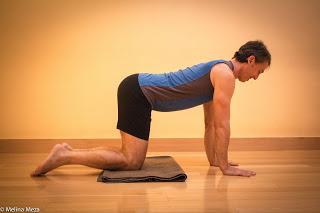 I actually recommend using a folded blanket even for students with healthy knees, as the upper shin bone and knee cap have very little padding and floors, even with a sticky mat on them, are hard. In addition to the use of a single blanket to pad sensitive or painful knees (near top of shin and where the knee cap is), if one is insufficient to relieve discomfort, I recommend trying 2 or 3 stacked blankets, and, in some situations, even a bolster.
I actually recommend using a folded blanket even for students with healthy knees, as the upper shin bone and knee cap have very little padding and floors, even with a sticky mat on them, are hard. In addition to the use of a single blanket to pad sensitive or painful knees (near top of shin and where the knee cap is), if one is insufficient to relieve discomfort, I recommend trying 2 or 3 stacked blankets, and, in some situations, even a bolster.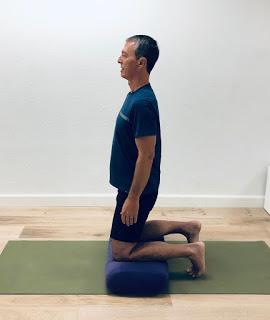 And speaking of an “apparatus,” there is a yoga prop called Yoga Jellies that has been around for 10 years or so, which are shaped like a thick pancake with a depression in the center. Several of my students find them useful in padding the knee/kneecap area.
And speaking of an “apparatus,” there is a yoga prop called Yoga Jellies that has been around for 10 years or so, which are shaped like a thick pancake with a depression in the center. Several of my students find them useful in padding the knee/kneecap area. 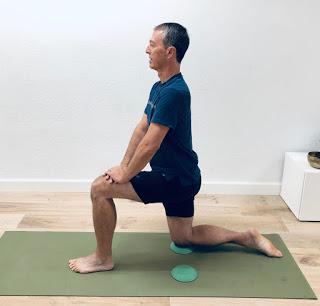 One other consideration for post-replacement knees is that following surgery the range of motion of the knees remains somewhat limited, despite the welcome improvement in pain relief. My brother, for example, was told not to expect his knee bending to be much better than it was just before his surgery, which was only about 90 degrees of flexion (compared to my 160 degrees in Child’s pose). In such a situation, in poses that require deep bend of the knees, placing a bolster or thick roll of blankets behind the knees may feel more supportive and comfortable than simply having the hips hovering unsupported high above the heels. For pain in knees that is unrelated to a knee replacement—especially if the pain is from arthritis—all same techniques for using props that I described above can be very helpful for you as well. In addition, for conditions other than knee replacement, since the deep bend of the knee can create compression in the knee joint—which can be painful for those with knee issues—reducing the bend of the knee or using a prop to create some space in the joint often eliminates that pain. For example, sitting on one or several blocks or a bolster in Hero’s pose may help to keep the knee joint open enough to do the pose without triggering pain. Or, you could use a thin roll behind the knee joints to create more space. ( See post: Getting Comfortable in Hero Pose) The same kind of propping can also work nicely for Child’s pose. Some students with knee pain complain about it in seated poses, such as Easy Sitting Pose, Cobbler’s Pose, and One-Legged Seated Forward Bend (Janu Sirsasana), especially if the knees are up as high or higher than the hips. Placing blocks under the outer knees so the knees are supported by the blocks often relieves the pain. The same type of support for the knees can be helpful for Reclined Cobbler’s pose as well.
One other consideration for post-replacement knees is that following surgery the range of motion of the knees remains somewhat limited, despite the welcome improvement in pain relief. My brother, for example, was told not to expect his knee bending to be much better than it was just before his surgery, which was only about 90 degrees of flexion (compared to my 160 degrees in Child’s pose). In such a situation, in poses that require deep bend of the knees, placing a bolster or thick roll of blankets behind the knees may feel more supportive and comfortable than simply having the hips hovering unsupported high above the heels. For pain in knees that is unrelated to a knee replacement—especially if the pain is from arthritis—all same techniques for using props that I described above can be very helpful for you as well. In addition, for conditions other than knee replacement, since the deep bend of the knee can create compression in the knee joint—which can be painful for those with knee issues—reducing the bend of the knee or using a prop to create some space in the joint often eliminates that pain. For example, sitting on one or several blocks or a bolster in Hero’s pose may help to keep the knee joint open enough to do the pose without triggering pain. Or, you could use a thin roll behind the knee joints to create more space. ( See post: Getting Comfortable in Hero Pose) The same kind of propping can also work nicely for Child’s pose. Some students with knee pain complain about it in seated poses, such as Easy Sitting Pose, Cobbler’s Pose, and One-Legged Seated Forward Bend (Janu Sirsasana), especially if the knees are up as high or higher than the hips. Placing blocks under the outer knees so the knees are supported by the blocks often relieves the pain. The same type of support for the knees can be helpful for Reclined Cobbler’s pose as well. 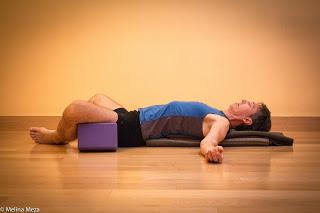 If there is some side-to-side instability in the knee joint, with or without pain, in symmetrical standing poses where the legs are close together, such as Mountain Pose, Arms Overhead Pose, Standing Forward Bend Pose, and Powerful Pose, placing a block between the inner thighs can be stabilizing. Place the block between your thighs on its narrow or middle width edge, whichever feels better, and stand with your feet as wide apart as the block. Then actively squeeze the block with your thighs to stabilize the knee joints.
If there is some side-to-side instability in the knee joint, with or without pain, in symmetrical standing poses where the legs are close together, such as Mountain Pose, Arms Overhead Pose, Standing Forward Bend Pose, and Powerful Pose, placing a block between the inner thighs can be stabilizing. Place the block between your thighs on its narrow or middle width edge, whichever feels better, and stand with your feet as wide apart as the block. Then actively squeeze the block with your thighs to stabilize the knee joints. 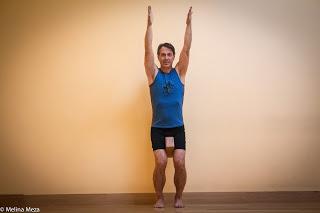 In addition, for some painful knee conditions, such as arthritis and meniscal tears (*excluding a tear or repair of the deep knee ligament, the anterior cruciate ligament (ACL)), making space in the knee joint can also be helpful, such as by tucking a rolled up towel or blanket between the hamstrings and calves in Hero pose (and poses with one or both leg in Hero pose position) as well as Child’s pose can also create space in the knee joint to relieve pain. (see version 3 of Child’s pose in Featured Pose: Child's Pose).
In addition, for some painful knee conditions, such as arthritis and meniscal tears (*excluding a tear or repair of the deep knee ligament, the anterior cruciate ligament (ACL)), making space in the knee joint can also be helpful, such as by tucking a rolled up towel or blanket between the hamstrings and calves in Hero pose (and poses with one or both leg in Hero pose position) as well as Child’s pose can also create space in the knee joint to relieve pain. (see version 3 of Child’s pose in Featured Pose: Child's Pose). 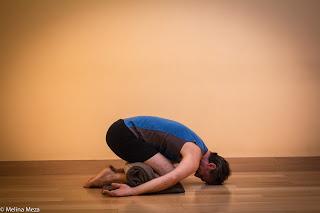 You can also use a spacer behind the knee joint in seated poses where one deeply bent knee is out to the side, such as Janu Sirsasana, or pointed up, such as Marichyasana 1 and 3. Do you have any favorite props to support the knees in yoga poses? —Baxter
You can also use a spacer behind the knee joint in seated poses where one deeply bent knee is out to the side, such as Janu Sirsasana, or pointed up, such as Marichyasana 1 and 3. Do you have any favorite props to support the knees in yoga poses? —Baxter Here are two other blog posts related to this topic: In Friday Q&A: Alignment of the Knees I discuss the use of block between thighs for knee pain in Powerful Pose.In Friday Q&A: Knee Restrictions I discuss working with knee pain in the condition Patellofemoral Syndrome and who should avoid certain movements of the knees.Subscribe to Yoga for Healthy Aging by Email ° Follow Yoga for Healthy Aging on Facebook and Twitter ° To order Yoga for Healthy Aging: A Guide to Lifelong Well-Being, go to Amazon, Shambhala, Indie Bound or your local bookstore.Follow Baxter Bell, MD on YouTube, Facebook, and Instagram. For upcoming workshops and retreats see Baxter's Workshops and for info on Baxter see baxterbell.com.

